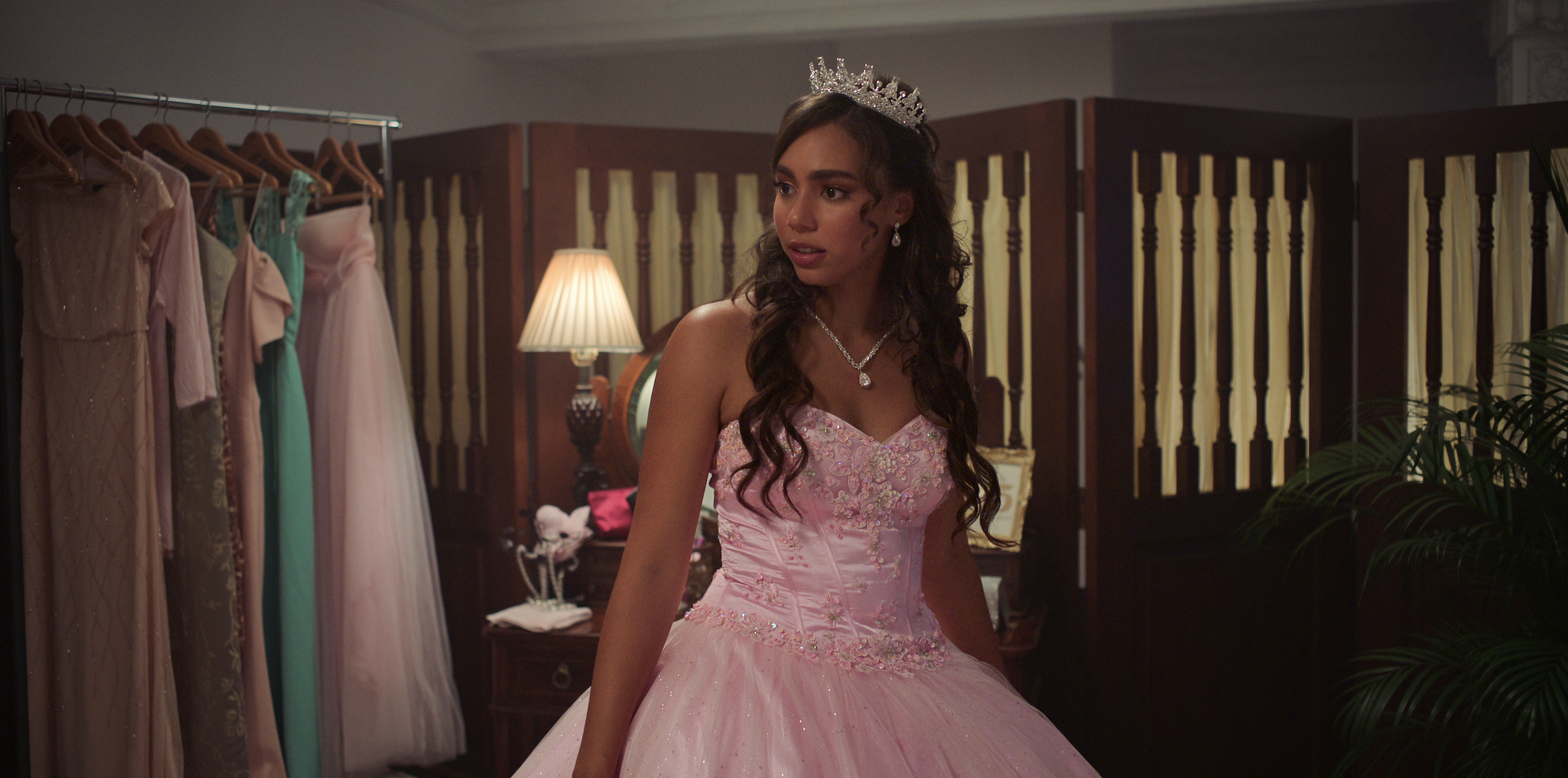
Warning: This story contains spoilers for Neon
Years ago, La Gata, the woman behind the Reggaeton Con La Gata platform, had a quinceañera. The celebration comprised two factions: older religious family members and young people “perreando to the ground.” The boy she had been dating at the time showed up, and she really wanted to dance with him to Jowell & Randy’s explicit “Sácala a Bailar,” but she knew her mom would intervene.
“So my friends said, 'Wall!'” La Gata says. “And they made a wall and they were literally blocking the view from the religious viejitos.”
Years later, this story is immortalized in Neon, Netflix’s new comedy about three friends who move to Miami to make it big in reggaeton. Santi (Tyler Dean Flores), Ness (Emma Ferreira), and Felix (Jordan Mendoza) are ready to make their dreams come true—especially because Santi’s song “Exagaro” has gone viral and the trio has snagged a meeting in the city with someone they believe to be a record label executive. In the quinceañera-inspired flashback scene, Ness’ friends form a wall so she can dance freely with the girl she likes.
Co-created by Shea Serrano and Max Searle, Neon pulses with a reverence for reggaeton’s history and influence. Over eight episodes, stacked with appearances from reggaeton greats, from Daddy Yankee to Jhayco, the show traces the roller coaster of trying to succeed in the music industry while keeping friendships strong. But it is, first and foremost, a comedy.
“I loved that [Serrano] was approaching this from a perspective of joy, of comedy,” La Gata says. “One thing I've always noticed is that this music was created as a medium of resistance. Joy is a medium of resistance.”
Read More: Bad Bunny Says Women are the Future of Reggaeton
Set against the lush backdrop of Miami, Neon doesn’t shy away from the harsher side of the music business either. La Gata consulted on Neon alongside the Los Angeles Times columnist Suzy Exposito and the two worked to ensure the show reflects reality while keeping the plot moving. In the show, Santi, Ness, and Felix’s initial plans quickly fall through.
Mia (Courtney Taylor), a young Black assistant to an executive at a record label, reached out to the group posing as an executive herself, someone with the capacity to offer them a record deal and sign them to the label. When her boss finds out, he fires her—though he still offers to meet with Santi, who was only given the opportunity through Mia’s tenacity. In the writers’ room, La Gata felt conflicted about that moment.
“But I was like, ‘Nah, the world needs to see this,’” she says. “Because Black girls in Latin music, where are we even? Let's be real.”

Oftentimes, there’s a lot of opposition toward Black women in the music industry, especially in reggaeton, a fact that La Gata knows firsthand all too well. In the show, Mia receives support for her passion anyway, after her ruse is uncovered. “It's the few people who pause” that make the biggest difference, La Gata says. “That pause is everything.”
Neon, which is “creative and funny and reverent,” isn’t supposed to be a documentary, says Exposito. At the same time, “I wanted to shine light not just on the fun aspects of working in the music industry, but also the challenges that being a musician requires,” she says. “Especially if you want to make it commercially, there are a number of obstacles that will be in your way, and we are very real about that. And especially if you're a young Latino, if you're working-class.”
Both Exposito and La Gata have made music and written extensively about reggaeton. Exposito, who is from Miami—the only place the show could be set, really—worked with the Cuban American TV writer Adriana Caballero to get the feel of the city right. There’s a lot of “glitz and glamor and mythology” surrounding Miami, Exposito says, but she also wanted to convey the more unforgiving aspects—both of the city and of the industry.
Exposito, born in the U.S., is also Cuban and Belizean. “Having a tri-cultural experience, reggaeton coming up when I was a teenager, it was something that helped me feel connected,” she says. “And I think I connected with reggaeton specifically because of its countercultural positioning in broader pop culture.”
Reggaeton’s roots stretch back to the early 20th century, when 50,000 West Indians migrated to Panama to build the Panama Canal. They brought with them reggae, which became reggae en español and fused with bomba, hip-hop, rap-soca, dancehall, salsa, and calypso to form reggaeton. The genre has developed—for better or for worse—to a place far from where it started, going global and edging closer to the pop mainstream, but it’s here to stay.
“Reggaeton, for me—it may sound cliché or too sure—but it is the future,” La Gata says. “As a historian, I'm impressed with how it constantly evolves. Reggaeton is here because it keeps reinventing itself, 30 years later.”
More Must-Reads from TIME
- Donald Trump Is TIME's 2024 Person of the Year
- Why We Chose Trump as Person of the Year
- Is Intermittent Fasting Good or Bad for You?
- The 100 Must-Read Books of 2024
- The 20 Best Christmas TV Episodes
- Column: If Optimism Feels Ridiculous Now, Try Hope
- The Future of Climate Action Is Trade Policy
- Merle Bombardieri Is Helping People Make the Baby Decision
Contact us at letters@time.com